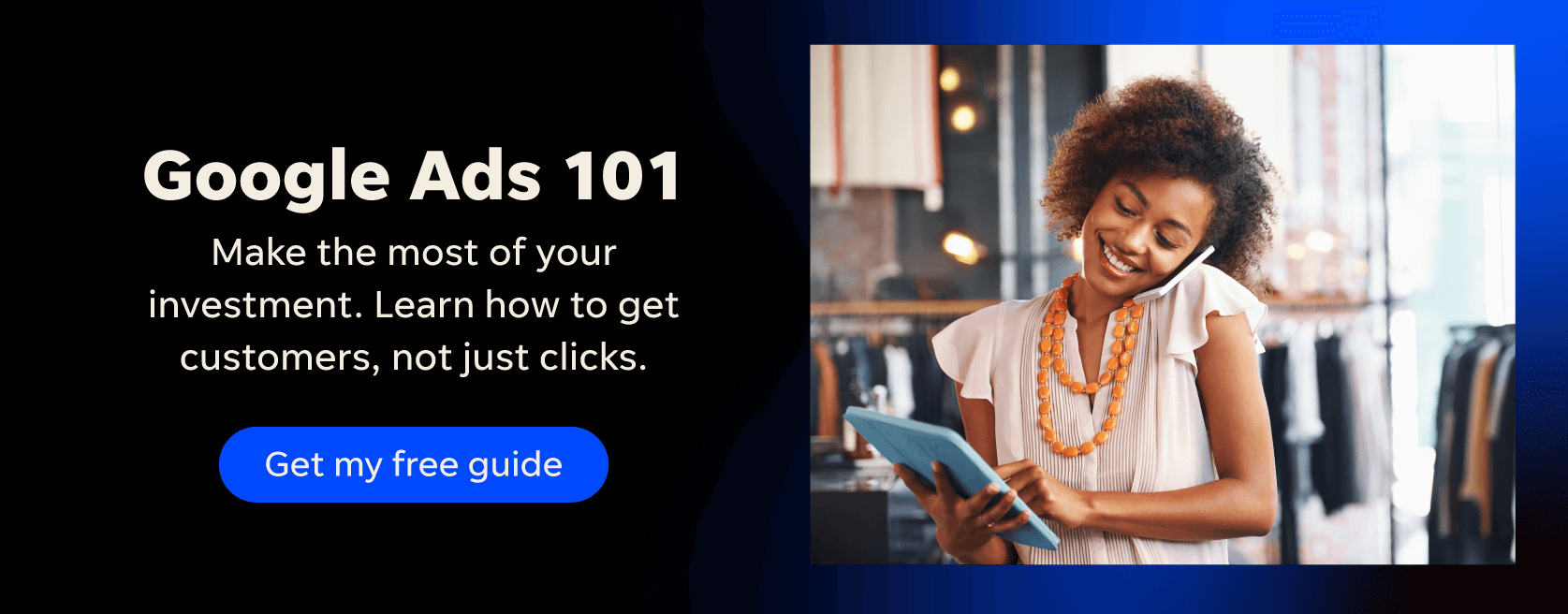Over 70% of people use search engines when looking to make a purchase. And a large percentage of those people are searching specifically for local products or services. Want to know the best way to capture local searchers and convert them into customers? The answer: local pay per click (PPC) advertising.
In this article, we’ll cover everything you need to know about local PPC, including how to create a successful local PPC strategy and high-converting ads.
Contents
- What is local PPC?
- Where do local PPC ads appear?
- How much does local PPC cost?
- What are the benefits of local PPC?
- How do you create a local PPC strategy?
- 5 tips for successful local PPC ads
What is local PPC?
First, let’s get this out of the way. PPC stands for pay per click, but this type of online advertising can also be called:
- Search engine marketing (SEM)
- Search advertising
- Paid search marketing
- Search marketing
- Google Ads
- Bing Ads
- Search engine ads
- Search engine advertising
- Pay-per-click (PPC) advertising
We may use some of these terms interchangeably, but they all mean the same thing, which is this:
Local PPC involves running paid search ads on top search engines to show up for searches with local intent.
Now, some specifics.
🛑 Already running Google Ads and not sure how they’re performing? Find out with a free, instant audit >> WordStream’s Free Google Ads Grader
Where do local PPC ads appear?
Local search ads appear in prime spots on the search engine results page (SERP), across multiple devices (mobile, tablet, desktop, etc.). Prime spots vary depending upon the search engine but typically are on top of organic results. All PPC ads are labeled with an “ad” or “sponsored” designation (search engines change the label from time to time).

Local PPC ads can also appear in the Map pack on Google and within the Google Maps app.
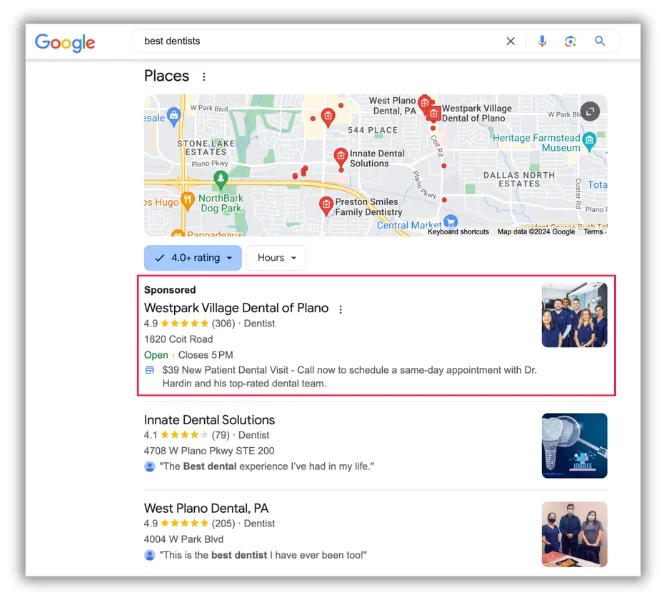
How much does local PPC cost?
When it comes to the cost of local PPC, you’ll be charged each time someone clicks on your ad (which is why it’s called pay-per-click advertising). Cost-per-click varies by industry, keyword, geography, and competition, and will also vary regularly throughout a campaign. We have some helpful PPC benchmarks here.
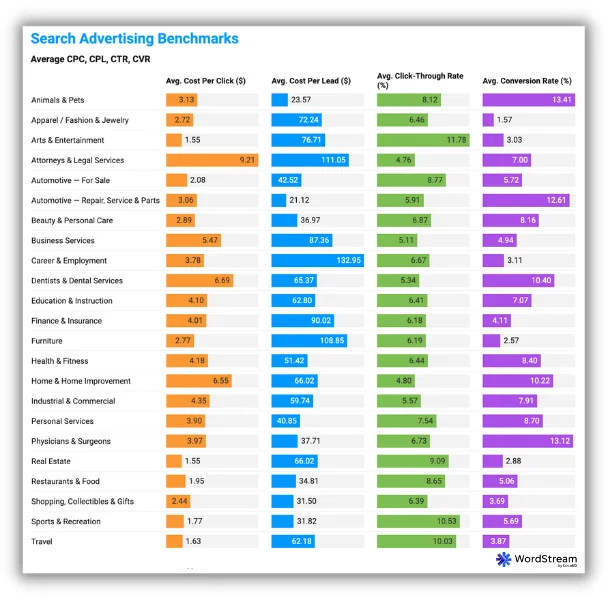
Now that you have some basics down, let’s talk about why local search advertising is important.
💰 Want a deeper breakdown of local PPC costs? Get our latest Search Ads Benchmarks!
What are the benefits of local PPC?
Local PPC isn’t a free marketing strategy–it does incur a cost and requires a budget, planning, and knowledge of how to execute PPC campaigns. But it’s also one of the best ways to get found by new customers and grow your business.
Here are some of the top reasons local PPC is a must for any local marketing strategy.
Drives quick results
You may be wondering, why pay to show up in search engines and have people click on your website pages? Can’t you just improve your website’s SEO and get online visibility and organic clicks for free?
SEO strategies are very beneficial to your business, but local SEO takes time to take effect, (up to six months, at least) and the tactics involve a lot of work toward producing quality content. With local SEM campaigns, you can see results right away in the form of your business name on page one of search results pages.
Helps your business rank on search engines
There’s limited real estate for the top positions in local organic search results. With the amount of content on the web today and the amount of competitors you have, it can be hard to get in a top position, even despite your best efforts.
If you’re a new business or an existing one trying to build your online presence, local search advertising can get you in front of highly targeted customers without a ton of effort.

🔎 Want searchers to see (and click on!) your site? Download our free guide >> Ways to Make Your Website More Visible on Google
Drives conversions
Another one of the benefits of local PPC is that people who see your local search ads are those most likely to want to buy your product or service. Your local PPC campaign requires you to choose a geographic location and specific search queries to target (more on that later).
As a result, you can be sure that anyone who clicks on your ad is not arbitrarily surfing the web, but rather, is looking for your product or service in the specific area you’re targeting.
Provides reporting and analytics
After a potential customer clicks your local PPC ad and reaches your website, pay-per-click ad services (such as through Google and Bing) enable you to collect data on each click, such as:
- Where that person is located.
- How much time they spent on your site.
- What pages they visited on your site.
- What type of device they were using (mobile, tablet, laptop).
With this data, those who click on your ad can become leads for you to contact later.
Real-time and specific tracking are huge benefits of local search advertising that allow you to see exactly what you’re getting for every marketing dollar you spend and obtain more leads in the long run.
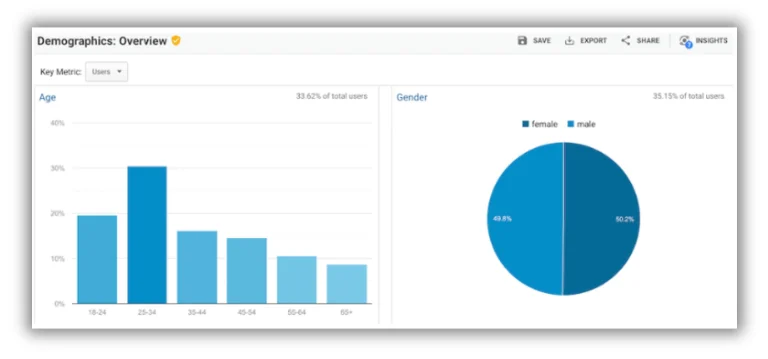
Now that you understand why local PPC is so important, let’s talk about how to get started with a local SEM strategy.
How to create a local PPC strategy
Local PPC isn’t one of those marketing strategies you can just jump right into. It requires planning, expertise, and budget. Here are the basics of a successful local PPC strategy.
Determine your goal
Before you start any local marketing plan, it’s important to outline your goal for the campaign. When it comes to local SEM, there are a few different goals you can consider:
- Getting more website clicks
- Generating leads
- Increasing sales
- Driving phone calls
- Driving in-person visits
- And more
The goal of your local PPC campaign will help inform your overall strategy, including your PPC keywords, budget, and ad copy.
Set your budget
Because local PPC is built around paying for each click, it’s important to designate a monthly budget. You’ll want to base this on your industry, geography, and the number of products and services you’re trying to advertise. Your budget will influence how much money you can spend throughout a month on PPC ads, and your spend level may vary daily.
Here’s an example of how you might calculate your local PPC budget based on cost per click (CPC):
Let’s say one customer is worth $500, and it takes 10 leads to get one customer. So, that makes one lead worth $50, which means you can’t spend more than $50 per lead to be profitable. Taking it one step further, if it takes 10 clicks to get one lead (one in 10 fill out the form), you can ultimately spend up to $5 per click.
While you can come up with thresholds for your budget, Google will determine the exact CPC based on your budget as well as the quality of your ad and landing page and its click-through rate in relation to your competitors. Here’s a graphic that illustrates how CPC is determined:

Once you know how much you can spend per click, you simply scale it up to your daily budget.
Determine your local PPC keywords
With your max CPC worked out, it’s time to pick the keywords you’ll use in your campaigns. The Google Keyword Planner is a great tool for doing this, and WordStream has a free keyword tool you can use as well.
To start, brainstorm some keywords that are related to your products and services to get a good baseline, and use the Keyword Planner to expand your list and generate new ideas. Ideally, you’ll want to find keywords that have high search volume, low competition, and fit within your max CPC plan.

The Keyword Planner provides you with an abundance of valuable information and sorting options. Be sure to spend some time getting familiar with it so you can master the research process for future campaigns.
If you’re working with a local advertising agency, they can determine the best keywords for you to use so you don’t have to dive too deep into this step.
Write your ad copy
Now it’s time to actually write the ad. Again, if you’re working with a local PPC company, they’ll take care of this for you, but if you’re doing it yourself or just want to know the steps, then this is the next one!
Having only a few lines to work with, you need to keep your ad short and to the point, while demonstrating your unique value proposition (UVP). This will take some trial and error before you get it down, but you’ll want to write multiple versions of an ad so you can do A/B testing to see what works best.
The main factors to a good ad are keyword headlines with actionable intent, making your URL visible to show users that your ad is relevant, the ad copy itself, and using a clear call to action.
You want your PPC ad copy to entice searchers to click on your ad, so including offers and specials is always a good idea.
Here are a few examples of good local PPC ads:

Make sure you have a relevant landing page
All local PPC campaigns link back to a page on your website, and you want to make sure that the page you’re leading searchers to is relevant to your ad copy. Many businesses will create dedicated landing pages for their local PPC campaigns to increase relevancy, which can help your ads perform–and convert–better.
If you don’t have landing pages you can link to, make sure that the page on your website closely matches the copy of your ad. For example, you don’t want ad copy about leaf-blowing services to click through to a page about hedge trimming on your website. That would result in a potential customer abandoning your site without taking any action.
Run your local PPC ad
Once your ad is built, it’s ready to go live so you can start collecting valuable information about its performance, make adjustments, and ultimately, get leads. You can track factors like clickthrough rate (CTR), ad relevance, cost per conversion, Quality Score, CPC, and conversion rate.
As you spend more time analyzing, you’ll gain the necessary information to make informed decisions about your local search ads going forward.
Make adjustments to your campaign
After your local search ads have run for a while and you’ve started to see results, you can make adjustments based on what’s working and what’s not. It’s important to continue refining and optimizing your local search ads based on what’s driving not only clicks but also conversions. This will allow you to maximize your marketing budget and ensure you capture local searchers and converting them into customers.
We’ll go over even more tips to optimize your local SEM campaign next.
5 tips for successful local search ads
If you want to take your local PPC a step further and optimize your campaign, here are a few tips to help you get started.
1. Run two ads and check your bids
Simply put, bids are the amount of money you pay per click for each ad. But just because an ad may be getting a lot of clicks doesn’t mean it’s performing well; you have to look at how many of them are actually converting into leads or customers.
By that same token, it’s never a good idea to run just one ad, because then you’ll have nothing to compare it to. To start, we recommend running at least two ads so you can compare their performance side by side and see which one is yielding better results. Ultimately, you want to reduce the amount you’re spending on low-performing ads and increase your bid amount for higher-performing ads.
2. Experiment with keyword match types
We talked about determining your keywords and keyword list, but it’s also important to consider keyword match type and choose the match type that’s going to draw in the most targeted traffic. These determine the types of search queries Google will show your ad to, which are covered below.
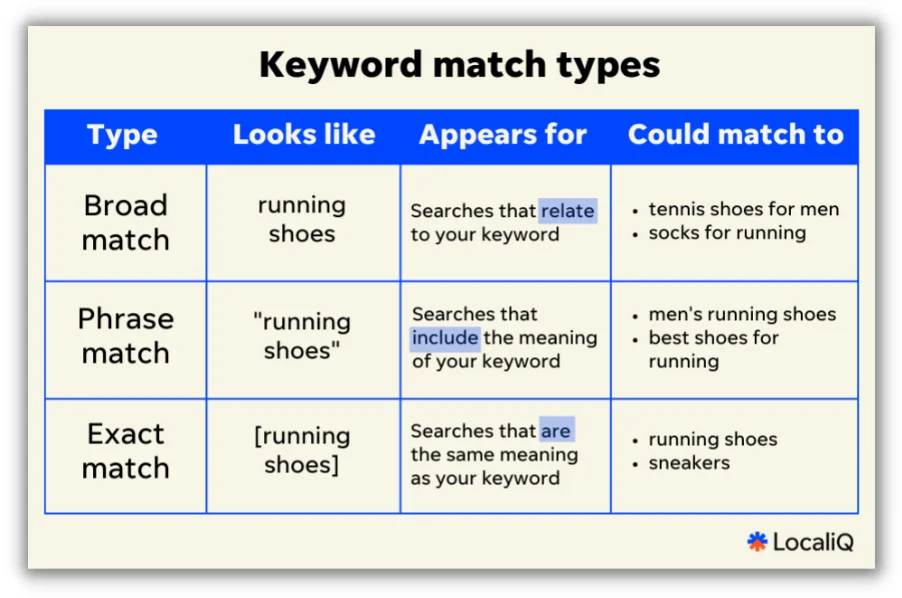
Broad match
Broad match will show your ad to anyone performing a Google search that includes your keyword in it, regardless of additional text in the query. This will give your ad the highest level of exposure, but you also run the risk of attracting the wrong kinds of customers to your landing page and wasting money.
For example, if you’re selling “men’s shoes,” you wouldn’t want someone searching for “men’s black shoe polish” clicking on your ad.
Phrase match
Phrase match tells Google to only show your ads to users who search for your keywords in the exact order you’ve entered them, while still allowing words before or after. This match type is a nice middle ground that allows you to narrow your ad reach to a more targeted market so you limit the number of irrelevant clicks you receive.
For example, if your keyword is “bar stools,” it can show up for searches like “cheap bar stools” or “buy bar stools.”
Exact match
Exact match is the most restrictive match type, only showing your ad to users who search for your keywords exactly as you’ve entered them with no text before or after. While this can greatly limit your ads’ reach, it increases the likelihood that users clicking on your ad will be interested in your product or service.
For example, if your keyword is “desk lamps,” your ad will only be shown to people who search that exact phrase.
There is no one-size-fits-all approach as it depends on your marketing goals and budget, so experiment to see which match type works best for you.
3. Add negative keywords
Negative keywords give you the ability to better control who Google shows your ads to. If you’re using broad or phrase match types, your ad can be shown to users who use additional words in their query, increasing the risk of appearing for irrelevant searches. For instance, if you’re selling “men’s suits” and they’re fairly high-end, you probably wouldn’t want to draw traffic searching for “cheap men’s suits.”
Negative keywords allow you to exclude search terms from your campaigns so you can focus on targeting the right kind of clicks.

To do this, start by brainstorming the obvious search queries you’d want to avoid. You’ll learn more about which negative keywords you should include for each ad as they continue to collect data and you can see the actual search phrases people are using, allowing you to limit exposure.
4. Add new keywords
As you know, keywords are going to determine who your ads are shown to. But, just because a keyword may be working for you one month doesn’t mean it will perform as well as the following.
As an online advertiser, you have to stay on top of the best-performing keywords and most popular search phrases that your target audience is using to get ahead of the game. Make it a habit of regularly checking and tracking the performance of your keywords so you know which ones to avoid and which ones to capitalize on.
This will help you identify trends and make it easier to adjust your bids accordingly. To come up with new keywords, use Google’s Keyword Planner tool (or any alternative keyword research tools) to find new ideas that you can build ads around.
5. Test ad copy
Outside of using the right keywords, negative keywords, and match types to design an effective paid search campaign, it’s the ad copy that will ultimately determine whether or not someone clicks on your ad. You don’t have to be a writing wizard when it comes to PPC ad copy. In fact, sometimes keeping it simple and to the point works best.
Experiment with different power words and phrases that clearly define what you’re offering. If you’re having a hard time, don’t be afraid to look at competitor ads to see what’s working for them.
Make local PPC a big hit for your business
Local PPC is your best bet to capture high-intent local searchers. Using these tips, best practices, and insights, you can create a winning local PPC strategy that helps your business grow.
Need help? Reach out for a free demo!
Related Articles
-

9 Reasons Your Google Ads Are Failing (Exclusive Expert Insights!)
-

How Much Does Google Ads Cost in 2024? (+Tips to Lower Costs)
-

7 Quick PPC Optimization Tips for Small Businesses in 2024
-

9 Ways to Build the Best Paid Search Strategy in 2024
-

7 Google Ads Optimization Tips to Maximize ROI Now (+Free Checklist)

